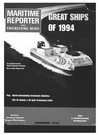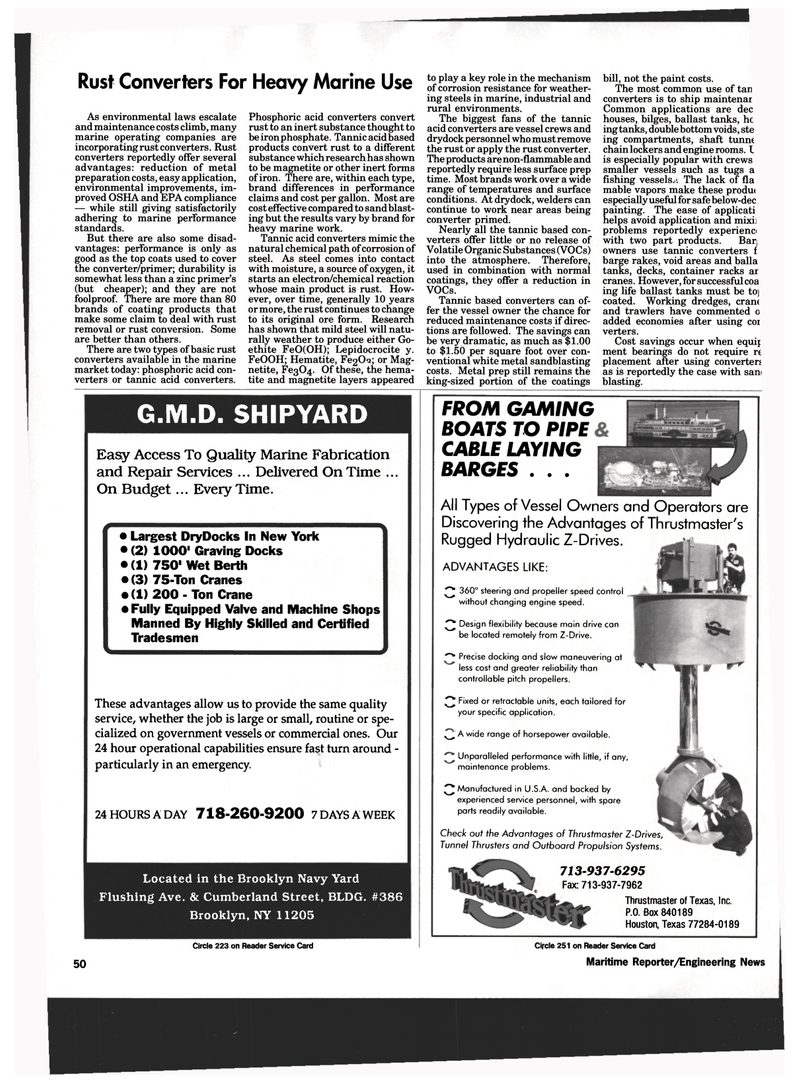
Page 50: of Maritime Reporter Magazine (December 1994)
Read this page in Pdf, Flash or Html5 edition of December 1994 Maritime Reporter Magazine
Rust Converters For Heavy Marine Use
As environmental laws escalate and maintenance costs climb, many marine operating companies are incorporating rust converters. Rust converters reportedly offer several advantages: reduction of metal preparation costs, easy application, environmental improvements, im- proved OSHA and EPA compliance — while still giving satisfactorily adhering to marine performance standards.
But there are also some disad- vantages: performance is only as good as the top coats used to cover the converter/primer; durability is somewhat less than a zinc primer's (but cheaper); and they are not foolproof. There are more than 80 brands of coating products that make some claim to deal with rust removal or rust conversion. Some are better than others.
There are two types of basic rust converters available in the marine market today: phosphoric acid con- verters or tannic acid converters.
Phosphoric acid converters convert rust to an inert substance thought to be iron phosphate. Tannic acid based products convert rust to a different substance which research has shown to be magnetite or other inert forms of iron. There are, within each type, brand differences in performance claims and cost per gallon. Most are cost effective compared to sand blast- ing but the results vary by brand for heavy marine work.
Tannic acid converters mimic the natural chemical path of corrosion of steel. As steel comes into contact with moisture, a source of oxygen, it starts an electron/chemical reaction whose main product is rust. How- ever, over time, generally 10 years or more, the rust continues to change to its original ore form. Research has shown that mild steel will natu- rally weather to produce either Go- ethite FeO(OH); Lepidocrocite y.
FeOOH; Hematite, Fe20Q; or Mag- netite, FegO^ Of these, the hema- tite and magnetite layers appeared to play a key role in the mechanism of corrosion resistance for weather- ing steels in marine, industrial and rural environments.
The biggest fans of the tannic acid converters are vessel crews and drydock personnel who must remove the rust or apply the rust converter.
The products are non-flammable and reportedly require less surface prep time. Most brands work over a wide range of temperatures and surface conditions. At drydock, welders can continue to work near areas being converter primed.
Nearly all the tannic based con- verters offer little or no release of
Volatile Organic Substances (VOCs) into the atmosphere. Therefore, used in combination with normal coatings, they offer a reduction in
VOCs.
Tannic based converters can of- fer the vessel owner the chance for reduced maintenance costs if direc- tions are followed. The savings can be very dramatic, as much as $1.00 to $1.50 per square foot over con- ventional white metal sandblasting costs. Metal prep still remains the king-sized portion of the coatings bill, not the paint costs.
The most common use of tan converters is to ship maintenar
Common applications are dec houses, bilges, ballast tanks, he ing tanks, double bottom voids, ste ing compartments, shaft tunnt chain lockers and engine rooms. L is especially popular with crews smaller vessels such as tugs a fishing vessels. The lack of fla mable vapors make these produ< especially useful for safe below-dec painting. The ease of applicati helps avoid application and mixii problems reportedly experience with two part products. Bar) owners use tannic converters f barge rakes, void areas and balla tanks, decks, container racks ar cranes. However, for successful coa ing life ballast tanks must be to] coated. Working dredges, crane and trawlers have commented o added economies after using coi verters.
Cost savings occur when equij ment bearings do not require rt placement after using converters as is reportedly the case with san blasting.
G.M.D. SHIPYARD
Easy Access To Quality Marine Fabrication and Repair Services ... Delivered On Time ...
On Budget... Every Time. • Largest DryDocks In New York • (2) lOOO1 Graving Docks • (1) 750* Wet Berth • (3) 75-Ton Cranes • (1) 200 - Ton Crane • Fully Equipped Valve and Machine Shops
Manned By Highly Skilled and Certified
Tradesmen
These advantages allow us to provide the same quality service, whether the job is large or small, routine or spe- cialized on government vessels or commercial ones. Our 24 hour operational capabilities ensure fast turn around - particularly in an emergency. 24 HOURS A DAY 718-260-9200 7 DAYS A WEEK
ADVANTAGES LIKE:
All Types of Vessel Owners and Operators are
Discovering the Advantages of Thrustmaster's
Rugged Hydraulic Z-Drives. ^ 360° steering and propeller speed control without changing engine speed. ^ Fixed or retractable units, each tailored for your specific application. ^ A wide range of horsepower available.
Unparalleled performance with little, if any, maintenance problems. ^ Manufactured in U.S.A. and backed by experienced service personnel, with spare parts readily available. ^ Design flexibility because main drive can be located remotely from Z-Drive. ^ Precise docking and slow maneuvering at less cost and greater reliability than controllable pitch propellers.
Check out the Advantages of Thrustmaster Z-Drives,
Tunnel Thrusters and Outboard Propulsion Systems.
FROM GAMING
BOATS TO PIPE
CABLE LAYING
BARGES . . . 713-937-6295
Fax:713-937-7962
Thrustmaster of Texas, Inc.
P.O. Box 840189
Houston, Texas 77284-0189
Located in the Brooklyn Navy Yard
Flushing Ave. & Cumberland Street, BLDG. #386
Brooklyn, NY 11205 50
Circle 223 on Reader Service Card Circle 251 on Reader Service Card
Maritime Reporter/Engineering News

 49
49

 51
51
